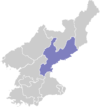Hamju County
This article needs additional citations for verification. (February 2022) |
Hamju County
함주군 | ||
|---|---|---|
Revised Romanization Hamju-gun | | |
 Map of South Hamgyong showing the location of Hamju | ||
| Country | North Korea | |
| Province | South Hamgyong Province | |
| Administrative divisions | 1 ŭp, 36 ri | |
| Area | ||
| • Total | 693 km2 (268 sq mi) | |
| Population (2008[1] ) | ||
| • Total | 133,896 | |
| • Density | 190/km2 (500/sq mi) | |
Hamju County (
South Hamgyong province, North Korea
.
Physical features
The county's highest point is Norabong. The chief river is the
foehn winds in the upland areas. Due to this, the climate is milder than the Yellow Sea
coastal regions.
Administrative divisions
Hamju county is divided into 1 ŭp (town) and 36 ri (villages):
|
|
Economy
Agriculture and fishery
In the level regions, a large amount of
red beans, soybeans, potatoes, and vegetables. Silkworms and livestock are also widely raised, and fishing
is carried out along the coast.
Mining
Mining also takes place, with deposits of iron ore, cuprite, and other minerals.
Transport
Hamju county is served by the
Kŭmgol lines of the Korean State Railway
, and by various roads.
See also
References
External links
- In Korean language online encyclopedias:

